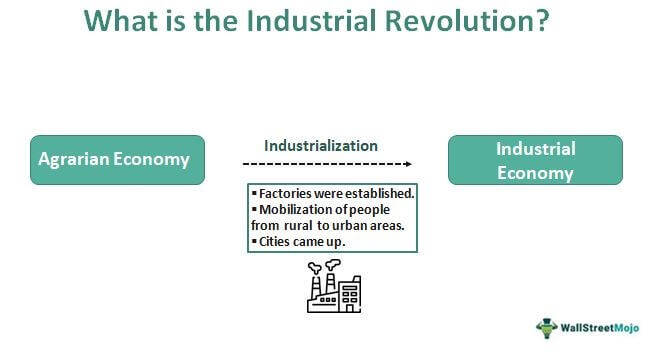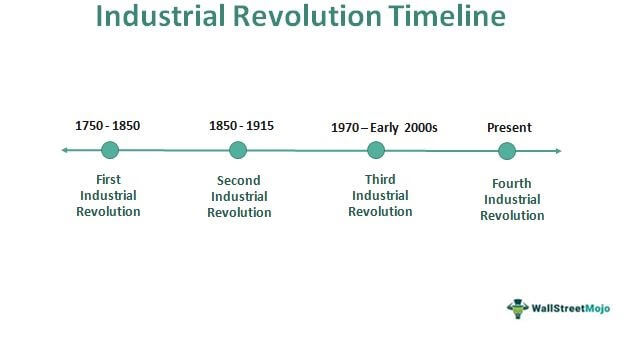Industrial Revolution Definition
The industrial revolution refers to a period of major economic transitions through new production processes. Over less than a century, from the late 1700s to somewhere before the 1840s, the First Industrial Revolution that started in Great Britain brought many innovations that introduced the economic shift from agriculture to mass industries.

You are free to use this image on your website, templates, etc, Please provide us with an attribution linkHow to Provide Attribution?Article Link to be Hyperlinked
For eg:
Source: Industrial Revolution (wallstreetmojo.com)
There have been four industrial revolutions, each of which transformed the domestic and global economy and reconstructed society. The industrial revolution and its consequences include industrialization, mechanization, globalization, digitization, and automation. It has been largely advantageous; however, industrial revolution constantly attributes to environmental damage and climate change.
Table of contents
- Industrial Revolution Definition
- Industrial Revolution Explained
- Industrial Revolution Timeline
- Causes
- Effects
- #1 – Shift from agrarian to industrial economies
- #2 – Urbanization
- #3 – Communism and socialism
- #4 – Changes in the economic and social front
- #5 – Technological developments
- #6 – Exploitation of colonies
- #7 – Globalization
- #8 – Greater choice of goods at low prices
- #9 – Development of management styles and techniques
- #10 – Environmental damage and pollution
- Frequently Asked Questions (FAQs)
- Recommended Articles
Key Takeaways
- The industrial revolution refers to a period of mass industrialization and mechanization, which marks the shift from rural to urban economies.
- The first industrial revolution began around the mid-1700s in Great Britain and spread to the rest of the world by the mid-nineteenth century.
- The first revolution saw the growth of manufacturing factories, the second marked technological developments, the third revolution introduced many digital innovations, and the fourth one, industrial revolution 4.0 at present, seeks to transform the world through the internet and artificial intelligence.
Industrial Revolution Explained
The industrial revolution was one of the most important events in history that altered the world economy. Two hundred fifty years after the first revolution, most of what we see daily are its contributions. The vehicles on the road, electronic devices, appliances at home, and the technology we use are all innovations that began with the revolution.
The epicenter was England, powered by the assets of its colonies and growing capitalism. It spread to Europe and its colonies first, owing to its obvious benefits – employment opportunities, investments, use of resources, demand for consumer goods, etc.
The earliest industries are now visible in now-developed European countries, the United States, etc. These countries realized the negative impact of factories and moved the manufacturing industries to the developing countries. Lesser cost of resources in the developing countries was another reason. This transition happened between the second and third revolutions, specifically, the 1960s.
If not for the revolution, most of what we enjoy today would have been missing. This is because the revolution was not a one-time event. Instead, it kept evolving and upgrading, growing through the previous inefficiencies and errors. Now, after three major strides of revolution, the world stands at the fourth stride, envisioning previously unimaginable innovations almost everywhere.
The Google Assistant that takes people to the continental restaurant, the Alexa, which can light up our fireplace on command, the iPhone technology which can recognize faces even with masks on, and the augmented reality that merges the virtual world with the real one – all of this is possible, thanks to the great industrial revolution of the eighteenth century.
Financial Modeling & Valuation Courses Bundle (25+ Hours Video Series)
–>> If you want to learn Financial Modeling & Valuation professionally , then do check this Financial Modeling & Valuation Course Bundle (25+ hours of video tutorials with step by step McDonald’s Financial Model). Unlock the art of financial modeling and valuation with a comprehensive course covering McDonald’s forecast methodologies, advanced valuation techniques, and financial statements.
Industrial Revolution Timeline
Four revolutions have introduced major transformations in the global economy. Let’s discuss these in detail.

You are free to use this image on your website, templates, etc, Please provide us with an attribution linkHow to Provide Attribution?Article Link to be Hyperlinked
For eg:
Source: Industrial Revolution (wallstreetmojo.com)
#1 – First Industrial Revolution
It started in the late-1700s in England. Many factories came up which catered to the needs of the people. This was an era of mass production. Until the first revolution, people largely engaged in farming.
After the revolution, many people started working in factories, especially in textiles. Cities started coming up with capitalist establishments. Soon European philosophers started propagating opposing ideas like socialism and communism. One of the greatest inventions ever, the steam engine, was developed during this time.
But this was also the time that human activities started having a profound effect on the environment. The source of energy used initially to fuel the production was wood. Later coal gained prominence. Thus, the depletion of resources and environmental pollution aggressively started around the first revolution.
#2 – Second Industrial Revolution
Also known as the technological revolution, this period saw many developments and discoveries in science and technology. It was born out of the inefficiencies of the first revolution. Factories needed to pick up the pace and keep up with the demand. Also, there was pressure on the prices.
New developments in medicine, efficient machines, electricity, use of iron and steel in production are some important innovations of the second revolution. It culminated around 1915 with the beginning of World War I.
#3 – Third Industrial Revolution
This is the digital revolution that marked an important event in the history of humanity. It appeared in the late 1900s with the prior inventions of mathematician-inventors like Charles Babbage and Alan Turing. This period introduced many digital communications and computing devices.
Some important inventions of the third revolution are television sets, computers, microprocessors, music devices, mobile phones, and the internet.
#4 – Fourth Industrial Revolution
Also called Industry 4.0, it aims to revolutionize the use of the internet to make radical economic and social changes. The online payment systems, social media, internet of things, augmented reality and virtual reality, artificial intelligence, bots, industry automation, sensors, etc., are all a part of this revolution.
Many businesses have taken advantage of this revolution to keep their customers loyal, retain them, acquire new ones, and gain a competitive advantage. Governments, banks, educational institutions, and the agriculture sector, too, are using internet-enabled services.
Causes
Here are the factors that contributed to the growth of the first and successive revolutions.
#1 – Colonization
The British got access to the vast amount of natural resources in their colonies. Having realized their potential, they converted them into a more usable form and sold them to make profits.
#2 – Capitalism
With much of Europe going through political transformations, many capitalists were born, who set up industries, hired daily wage workers, produced in mass, and sold goods to people. Slowly, powered by huge profits, many capitalists took control of social establishments, which gave them the power to set up more factories.
#3 – Decline in the agricultural sector
With the increasing population, the scope of employment in agriculture declined. Often ten or more people did the work of two. Also, the income from farming was not sufficient for the people. The availability of such labor provided the necessary human resource required in the factories.
#4 – Political tensions in Europe
The first revolution couldn’t have happened at a better time, with the political tensions in many parts of Europe that changed the norm. Events like the French Revolution shaped Europe, with countries forming alliances. These tensions led to the revolution spreading to other parts of the continent.
Effects
The industrial revolution and its consequences have been so lasting that they have changed the world in many ways. Here is the list of some of its effects:
#1 – Shift from agrarian to industrial economies
Since most people were employed in the agriculture sector before the revolution, it provided many new opportunities for people to earn extra income. Therefore, many farmers started working as daily wage laborers at factories.
#2 – Urbanization
With the new opportunities in the factories, there was widespread mobilization from rural to urban areas, and cities started developing around industries.
#3 – Communism and socialism
These two ideologies were born due to capitalism, which was rife during industrialization. The idea that industries should be state-owned and not in the hands of private individuals shaped many countries like China and Russia.
#4 – Changes in the economic and social front
The revolution changed how the economy and society functioned. In many countries, the working class emerged as a social sector. Also, the revenue from industries became the main source of income for most countries, thus replacing agriculture.
#5 – Technological developments
Most innovations and inventions made during the revolution are still used, like the steam engine, coal-powered plants, etc. These inventions were constantly updated to meet the changing needs of the people.
#6 – Exploitation of colonies
Mass industrialization was only possible because of the huge amount of resources Europe managed to gain from the colonies. Especially textiles, spices, minerals, and other valuable metals, thus exploiting the colonies. The impact of this can still be seen in developing and under-developed countries.
#7 – Globalization
International trade flourished with countries trading resources and manufactured goods. It has improved access to technology and knowledge, supplied better alternatives to domestic goods, and provided new opportunities for local businesses.
#8 – Greater choice of goods at low prices
Since the era of revolution saw heavy industrialization and massive production, the main aim of factory owners was to sell the product to every person to make them dependent on the product and earn sales revenue. Also, with multiple businesses which started during this time, people were given different choices.
#9 – Development of management styles and techniques
Proper division of labor was followed in these factories – the owners or the capitalists, managers, supervisors, and finally, the workers. Over the years, the degree of success in such organizations has been studied to craft the perfect management style.
#10 – Environmental damage and pollution
Though the revolution had many benefits, there have also been equal negative impacts on the environment. Water pollution, air pollution, deforestation, land degradation, etc., are all the effects of the revolution. Due to this, climate change and global warming are growing concerns now. It was predicted that, in 2021, the CO2 levels in the atmosphere would reach 50% higher than in the pre-industrial era.
Frequently Asked Questions (FAQs)
The first revolution began somewhere around the 1760s in Great Britain.
Industrial revolution 4.0 is currently taking place and is changing the world drastically by introducing new technologies powered by the internet. It seeks to enhance the user experience and transform socio-economic traditions.
The invention of the steam engine is probably one of the most important in the world and has been the basis for many other inventions. The first model of the steam engine was a steam-powered water pump invented by Thomas Savery. It was used in mines and textiles. Later, modifications were introduced by Thomas Newcomen and James Watt, among others.
Colonization and capitalism are the two most important reasons for the birth of the revolution. At that time, England had many colonies, and capitalist ideas were gaining momentum. An ideal example is the East India Company, which along with the British monarchy, colonized many nations and exploited their resources, which were then altered to a usable form to make profits.
Recommended Articles
This article has been a guide to Industrial Revolution and its definition. Here, we explain the timeline, causes and effects of the industrial revolution. You can learn more from the following articles –


Leave a Reply